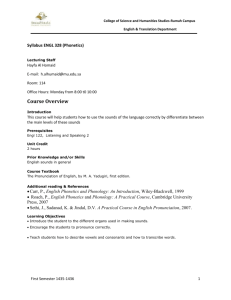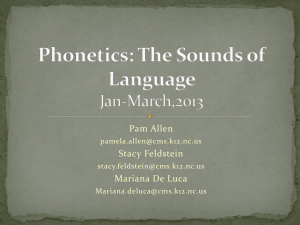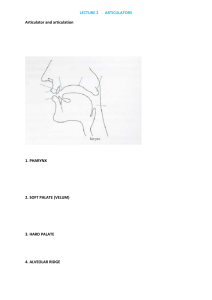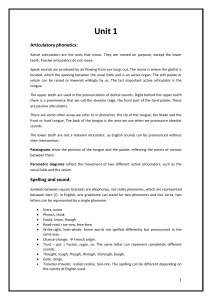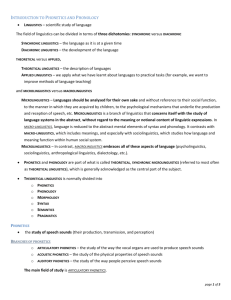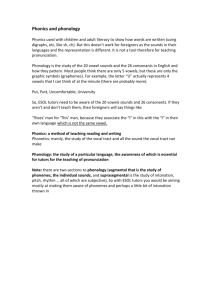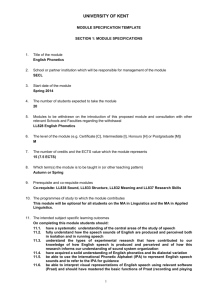PHONETICS AND PHONOLOGY
advertisement
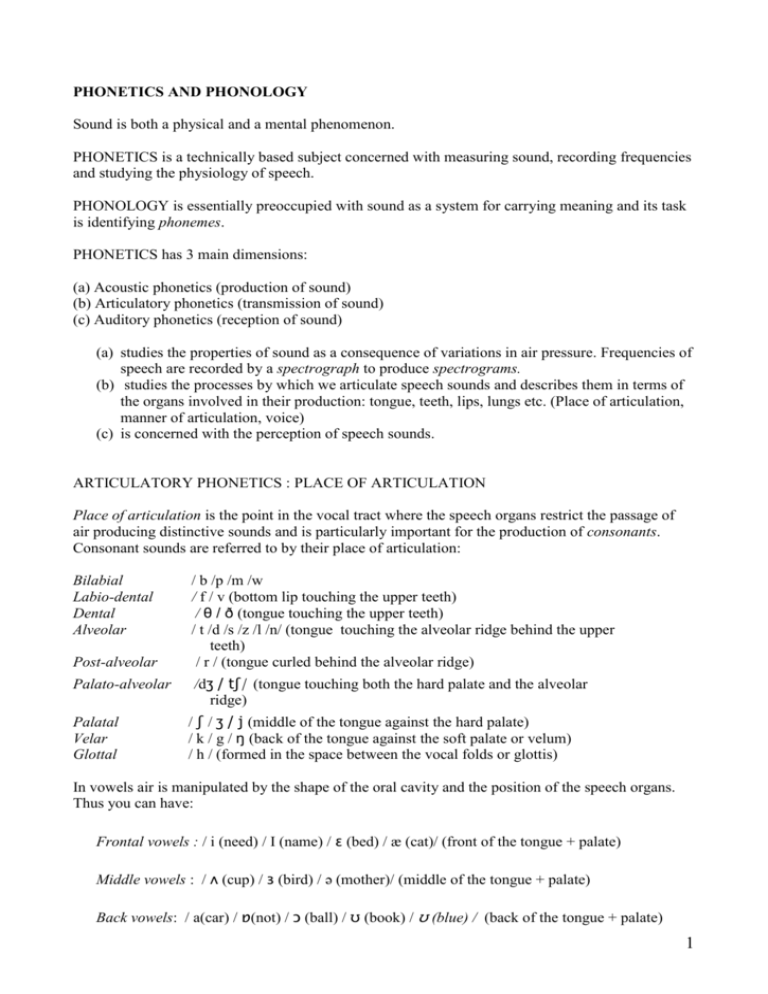
PHONETICS AND PHONOLOGY Sound is both a physical and a mental phenomenon. PHONETICS is a technically based subject concerned with measuring sound, recording frequencies and studying the physiology of speech. PHONOLOGY is essentially preoccupied with sound as a system for carrying meaning and its task is identifying phonemes. PHONETICS has 3 main dimensions: (a) Acoustic phonetics (production of sound) (b) Articulatory phonetics (transmission of sound) (c) Auditory phonetics (reception of sound) (a) studies the properties of sound as a consequence of variations in air pressure. Frequencies of speech are recorded by a spectrograph to produce spectrograms. (b) studies the processes by which we articulate speech sounds and describes them in terms of the organs involved in their production: tongue, teeth, lips, lungs etc. (Place of articulation, manner of articulation, voice) (c) is concerned with the perception of speech sounds. ARTICULATORY PHONETICS : PLACE OF ARTICULATION Place of articulation is the point in the vocal tract where the speech organs restrict the passage of air producing distinctive sounds and is particularly important for the production of consonants. Consonant sounds are referred to by their place of articulation: Bilabial Labio-dental Dental Alveolar Post-alveolar Palato-alveolar Palatal Velar Glottal / b /p /m /w / f / v (bottom lip touching the upper teeth) / θ / ð (tongue touching the upper teeth) / t /d /s /z /l /n/ (tongue touching the alveolar ridge behind the upper teeth) / r / (tongue curled behind the alveolar ridge) /dʒ / tʃ/ (tongue touching both the hard palate and the alveolar ridge) / ʃ / ʒ / j (middle of the tongue against the hard palate) / k / g / ŋ (back of the tongue against the soft palate or velum) / h / (formed in the space between the vocal folds or glottis) In vowels air is manipulated by the shape of the oral cavity and the position of the speech organs. Thus you can have: Frontal vowels : / i (need) / I (name) / ɛ (bed) / æ (cat)/ (front of the tongue + palate) Middle vowels : / ʌ (cup) / ɜ (bird) / ə (mother)/ (middle of the tongue + palate) Back vowels: / a(car) / ɒ(not) / ɔ (ball) / ʊ (book) / ʊ (blue) / (back of the tongue + palate) 1 ARTICULATORY PHONETICS : MANNER OF ARTICULATION Configuration adopted by the speech organs in articulating a sound. Plosives (stops) : / p / b / t / d/ k / g / (airstream is stopped by a brief closure) Fricatives : / f / v/ θ / ð /s / z / ʃ / ʒ / h / (friction occurs as air passes through) Affricates : /dʒ / tʃ/ (airstream is stopped as for a plosive and then released slowly with friction) / m / n / ŋ/ (airstream is diverted through the nasal cavity by lowering the soft palate) /l/r/ /w/j/ Nasals : Liquids : Glides : ARTICULATORY PHONETICS : VOICE Voicing occurs when the vocal folds or chords situated in the larynx vibrate. Voiced sounds : ex. / b / z / v / Voiceless sounds: ex. / p / s / f / AUDITORY PHONETICS This discipline studies the physical ways in which the sound waves we produce are converted into meaningful units of speech. The outer ear collects the sounds, the middle ear amplifies them, and the inner ear transmits them through the auditory nerve to the speech centres of the brain, the most important of which are Wernickes’s area and Broca’s area, both located in the left emisphere in right-handed people. There are various theories on how the brain reconstructs a word from a series of coarticulated sounds and speculations on the uniqueness and innateness of language. PHONOLOGY Phonology studies the systematic relationships between sounds within the grammar of a language. A phoneme is an abstract unit of sound which forms part of the mental apparatus of all the native users of a language. Some prefer to see these relationships just in terms of distinctive features (for example “voiced bilabial plosive” for a /b/) according to the theory elaborated by Roman Jakobson. Distinctive features are binary and can have only two values ‘ + ’ or ‘ – ’. Classificatory features: Consonantal (plosives, fricatives, affricates, nasals and liquids as opposed to vowels and glides) Vocalic (vowels and liquids) Syllabic (sounds which can function as the peak of a syllable, ex. vowels) 2 Obstruent ( sounds that involve radical obstruction of the airstream like plosives, fricatives and affricates as opposed to liquids, glides, nasals and vowels) Nasal Articulatory features: High (tongue above the rest position) Low (tongue below the rest position) Back (tongue retracted from the rest position) Round (lips rounded) Anterior (post-alveolar obstructon: labials, labio-dentals and alveolars) Coronal (blade of the tongue raised from the neutral position: dentals, alveolars, post-alveolars and palatals) Lateral (air escapes over the sides of the tongue / l / ) Manner features: Continuant (fricatives, approximants [liquides and glides] and vowels as opposed to plosives and affricates) Delayed release (affricates /dʒ / tʃ/) Acoustic features: Voice Strident (high-frequency sounds, ex. labio-dental, alveolar and palato-alveolar) PHONOLOGY studies also the patterns of stress we use in speaking and the variations of pitch or tone. The study of this is called Prosody and examines units larger than the phoneme, termed suprasegmentals, which become very important for Discourse analysis and Pragmatics. (Intonation) Phonological rules are also important for the study of Syntax and in particolar of Morphology. Morphological alterations have also a phonological side because they often involve pronunciation changes. Ex. Plural ‘s’ after belt, lane, beach ( / s / z / IZ ); ‘-ed ’ after stop, clean, want ( / t / d / id). The study of this is called Morphophonology. 3 INTONATION Term referred to the variations in the pitch of a speaker’s voice. Tone is the way in which pitch is used in language. There are tone languages but in English, like in Italian, tone has only a suprasegmental function. It contributes to determining meaning. A tone unit is conventionally said to have the following structure: (pre-head) – (head) – tonic/nuclear syllable – (tail) Example: There’s no need to be so upSET about it There’s (pre-head) No need to be so (head) upSET (tonic syllable) about it (tail) MOST COMMON TONES 1. 2. 3. 4. 5. Fall Rise-fall Fall-rise Rise Level 1. 2. 3. 4. 5. Falling is usually considered assertive, positive: That’s MINE Rising is polite, diffident, enquiring: COFFee? Falling-rising expresses doubt, uncertainty: I’m not SURE. Rising-falling is emphatic: How NICE! Level is neutral: I don’t MIND. Intonation is also linked to grammatical functions, for example to distinguish yes/no questions from wh- questions. Are you GOing? (rising) What’s the PROblem? (falling) Or to highlight new information. 4
